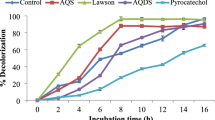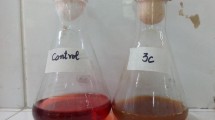Abstract
The effects of humic acid (HA) on azo dye decolorization by Shewanella oneidensis MR-1 were studied. It was found that HA species isolated from different sources could all accelerate the decolorization of Acid Red 27 (AR27). Anoxic and anaerobic conditions were required for the enhancement of azo dye decolorization by HA. In the presence of 50 mg DOC L−1 Aldrich HA, 15–29% increases in decolorization efficiencies of azo dyes with different structures were achieved in 11 h. The enhancing effects increased with the increase of HA concentrations ranging from 25 to 150 mg DOC L−1, and the decolorization rates were directly proportional to the HA concentrations when they were below 100 mg DOC L−1. Lactate and formate were good electron donors for AR27 decolorization in the presence of HA. Both nitrate (0.1–3.0 mM) and nitrite (0.3–1.2 mM) inhibited AR27 decolorization in the presence of HA, and negligible decolorization was observed before their removal. Soluble FeCl3 could accelerate the decolorization process in the presence of HA, whereas insoluble hematite could not. These findings may affect the understanding of bioremediation of azo dye-polluted environments and help improve the treatment of azo dye wastewaters.






Similar content being viewed by others
References
Benz M, Schink B, Brune A (1998) Humic acid reduction by Propionibacterium freudenreichii and other fermenting bacteria. App Environ Microbiol 64:45074–45512
Blümel S, Knackmuss J, Stolz A (2002) Molecular cloning and characterization of the gene coding for the aerobic azoreductase from Xenophilus azovorans KF46F. Appl Environ Microbiol 68:3948–3955
Brigé A, Ba M, Borloo J, Buysschaert G, Devreese B, Beeumen JJ (2008) Bacterial decolorization of textile dyes is an extracellular process requiring a multicomponent electron transfer pathway. Microbiol Biotechnol 1:40–52
Brown MA, DeVito SC (1993) Predicting azo dye toxicity. Crit Rev Environ Sci Technol 23:249–324
Cervantes FJ, de Bok FA, Duong-Dac T, Stams AJ, Lettinga G, Field JA (2002) Reduction of humic substances by halorespiring, sulphate-reducing and methanogenic microorganisms. Environ Microbiol 4:51–57
Cervantes FJ, Garcia-Espinosa A, Moreno-Reynosa MA, Rangel-Mendez JR (2010) Immobilized redox mediators on anion exchange resins and their role on the reductive decolorization of azo dyes. Environ Sci Technol 44:1747–1753
Cervantes FJ, Gonzalez-Estrella J, Márquez A, Alvarez LH, Arriaga S (2011) Immobilized humic substances on an anion exchange resin and their role on the redox biotransformation of contaminants. Biores Technol 102:2097–2100
Chen H (2006) Recent advances in azo dye degrading enzyme research. Curr Protein Pept Sci 7:101–111
Chen X, Sun G, Xu M (2010) Role of iron in azoreduction by resting cells of Shewanella decolorationis S12. J Appl Microbiol 110: 580–586
Dos Santos AB, Cervantes FJ, Van Lier JB (2007) Review paper on current technologies for decolourization of textile wastewaters: perspectives for anaerobic biotechnology. Bioresour Technol 98:2369–2385
Dubrow SF, Boardman GD, Michelsen DL (1996) Chemical pretreatment and aerobic–anaerobic degradation of textile dye wastewater. In: Reife A, Freeman HS (eds) Environmental chemistry of dyes and pigments. Wiley, New York, pp 75–102
Dunnivant FM, Schwarzenbach RP, Macalady DL (1992) Reduction of substituted nitrobenzenes in aqueous solutions containing natural organic matter. Environ Sci Technol 26:2133–2142
Hau HH, Gralnick JA (2007) Ecology and biotechnology of the genus Shewanella. Annu Rev Microbiol 61:237–258
Hong Y, Chen X, Guo J, Xu Z, Xu M, Sun G (2007a) Effects of electron donors and acceptors on anaerobic reduction of azo dyes by Shewanella oneidensis S12. Appl Microbiol Biotechnol 74:230–238
Hong Y, Guo J, Xu Z, Xu M, Sun G (2007b) Humic substances act as electron acceptor and redox mediator for microbial dissimilatory azoreduction by Shewanella decolorationis S12. J Microbiol Biotechnol 17:428–437
Hong Y, Xu M, Guo J, Xu Z, Chen X, Sun G (2007c) Respiration and growth of Shewanella decolorationis S12 with an azo compound as sole electron acceptor. Appl Environ Microbiol 73:64–72
Huang DY, Zhuang L, Cao WD, Xu W, Zhou SG, Li FB (2010) Comparison of dissolved organic matter from sewage sludge and sludge compost as electron shuttles for enhancing Fe(III) bioreduction. J Soils Sediment 10:722–729
Jiang J, Kappler A (2008) Kinetics of microbial and chemical reduction of humic substances: implication for electron shuttling. Environ Sci Technol 42:3563–3569
Khalid A, Muhammad A, Crowley DE (2008) Decolorization of azo dyes by Shewanella sp. under saline conditions. Appl Microbiol Biotechnol 79:1053–1059
Ko I, Kim JY, Kim KW (2005) Adsorption properties of soil humic and fulvic acids by hematite. Chem Spec Bioavailab 17:41–48
Kudlich M, Keck A, Klein J, Stolz A (1997) Localization of the enzyme system involved in the anaerobic reduction of azo dyes by Sphingomonas sp. BN6 and effect of artificial redox mediators on the rate of azo dye reduction. Appl Environ Microbiol 63:3691–3694
Liu G, Zhou J, Wang J, Zhou M, Lu H, Jin R (2009) Acceleration of azo dye decolorization by using quinone reductase activity of azoreductase and quinone redox mediator. Biores Technol 100:2791–2795
Lovley DR, Coates JD, Blunt-Harris EL, Phillips EJP, Woodward JC (1996) Humic substances as electron acceptors for microbial respiration. Nature 382:445–448
Luan F, Burgos WD, Xie L, Zhou Q (2010) Bioreduction of nitrobenzene, natural organic matter, and hematite by Shewanella putrefaciens CN32. Envrion Sci Technol 44:184–190
O'Loughlin EJ (2008) Effects of electron transfer mediators on the bioreduction of lepidocrocite (γ-FeOOH) by Shewanella putrefaciens CN32. Envrion Sci Technol 42:6876–6882
O'Loughlin EJ, Gorski CA, Scherer MM, Boyanov MI, Kemner KM (2010) Effects of oxyanions, natural organic matter, and bacterial cell numbers on the bioreduction of lepidocrocite (γ-FeOOH) and the formation of secondary mineralization products. Environ Sci Technol 44:4570–4576
Pandey A, Singh P, Iyengar L (2007) Bacterial decolorization and degradation of azo dyes. Int Biodeter Biodegr 59:73–84
Pearce CI, Lloyd JR, Guthrie JT (2003) The removal of colour from textile wastewater using whole bacterial cells: a review. Dyes Pigm 58:179–196
Pearce CI, Christie R, Boothman C, von Canstein H, Guthrie JT, Lloyd JR (2006) Reactive azo dye reduction by Shewanella strain J18 143. Biotechnol Bioeng 95:692–703
Ratasuk N, Nanny MA (2007) Characterization and quantification of reversible redox sites in humic substances. Environ Sci Technol 41:7844–7850
Ramos-Tejada MM, Ontiveros A, Viota JL, Durán JD (2003) Interfacial and rheological properties of humic acid/hematite suspensions. J Colloid Interface Sci 268:85–95
Rau J, Knackmus HJ, Stolz A (2002) Effects of different quinoid redox mediators on the anaerobic reduction of azo dyes by bacteria. Environ Sci Technol 36:1497–1504
Royer RA, Burgos WD, Fisher AS, Jeon BH, Unz RF, Dempsey BA (2002) Enhancement of hematite bioreduction by natural organic matter. Environ Sci Technol 36:2897–2904
Russ R, Rau J, Stolz A (2000) The fucntion of cytoplasmic flavin reductases in the reduction of azo dyes by bacteria. Appl Environ Microbiol 66:1429–1434
Saratale RG, Saratale GD, Chang JS, Govindwar SP (2011) Bacterial decolorization and degradation of azo dyes: a review. J Taiwan Inst Chem Engrs 42:138–157
Scott DT, McKnight DM, Blunt-Harris EL, Kolesar SE, Lovley DR (1998) Quinone moieties act as electron acceptors in the reduction of humic substances by humic-reducing microorganisms. Environ Sci Technol 32:2984–2989
Stolz A (2001) Basic and applied aspects in the microbial degradation of azo dyes. Appl Microbiol Biotechnol 56:69–80
Van Trump JI, Sun Y, Coates JD (2006) Microbial interactions with humic substances. Adv Appl Microbiol 60:55–96
Wolf M, Kappler A, Jiang J, Meckenstock RU (2009) Effects of humic substances and quinones at low concentrations on ferrihydrite reduction by Geobacter metallireducens. Environ Sci Technol 43:5679–5685
Wu J, Kim KS, Sung NC, Kim CH, Lee YC (2009) Isolation and characterization of Shewanella oneidensis WL-7 capable of decolorizing azo dye Reactive Black 5. J Gen Appl Microbiol 55:51–55
Xu H, Heinze TM, Chen S, Cerniglia CE, Chen H (2007a) Anaerobic metabolism of 1-amino-2-naphthol-based azo dyes (Sudan dyes) by human intestinal microflora. Appl Environ Microbiol 73:7759–7762
Xu M, Guo J, Kong X, Chen X, Sun G (2007b) Fe(III)-enhanced azo reduction by Shewanella decolorationis S12. Appl Microbiol Biotechnol 74:1342–1349
Acknowledgements
The work was financially supported by the National Natural Science Foundation of China (No. 51008044 and 50978040), Fundamental Research Funds for the Central Universities, China Postdoctoral Science Foundation (20100471435 and 200902538), Program for Changjiang Scholars and Innovative Research Team in University (PCSIRT0814), and National Key Scientific and Technology Project for Water Pollution Treatment of China (2008ZX07208-004-2).
Author information
Authors and Affiliations
Corresponding author
Rights and permissions
About this article
Cite this article
Liu, G., Zhou, J., Wang, J. et al. Decolorization of azo dyes by Shewanella oneidensis MR-1 in the presence of humic acids. Appl Microbiol Biotechnol 91, 417–424 (2011). https://doi.org/10.1007/s00253-011-3273-8
Received:
Revised:
Accepted:
Published:
Issue Date:
DOI: https://doi.org/10.1007/s00253-011-3273-8




